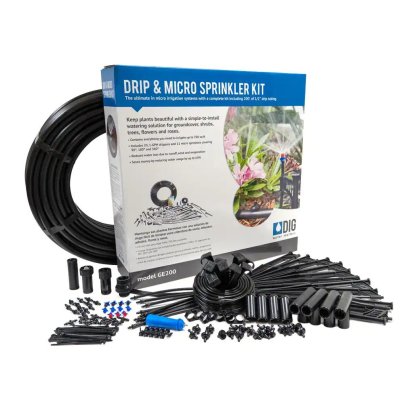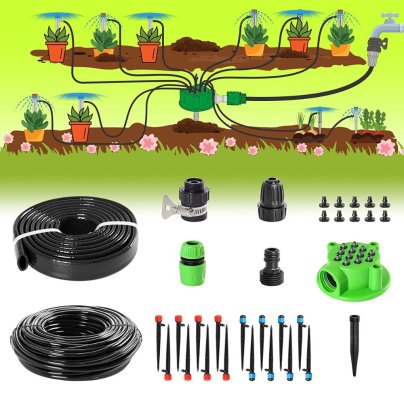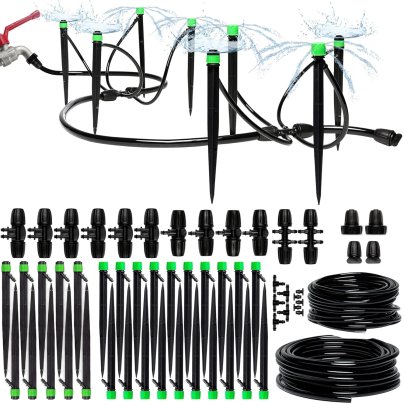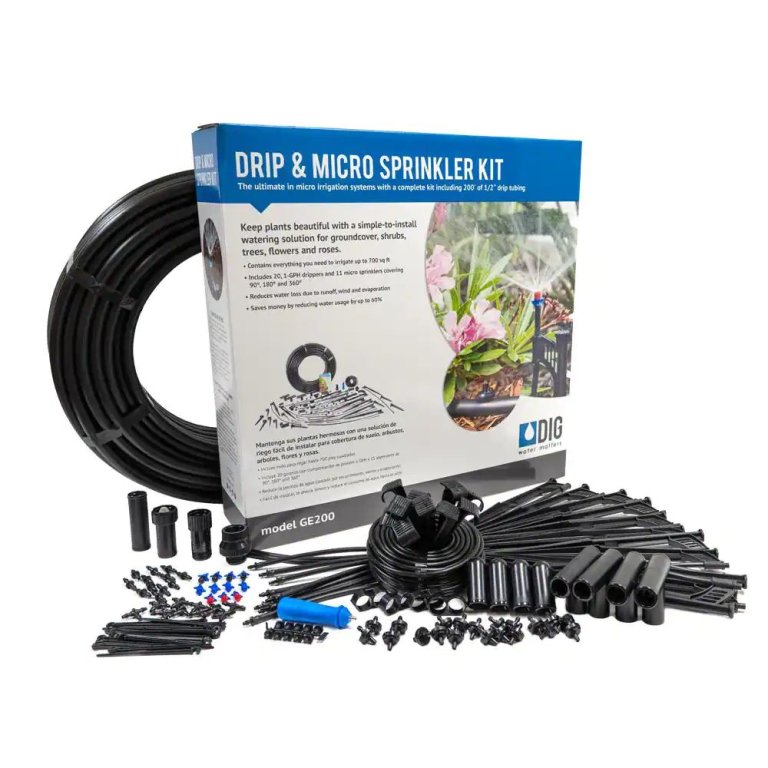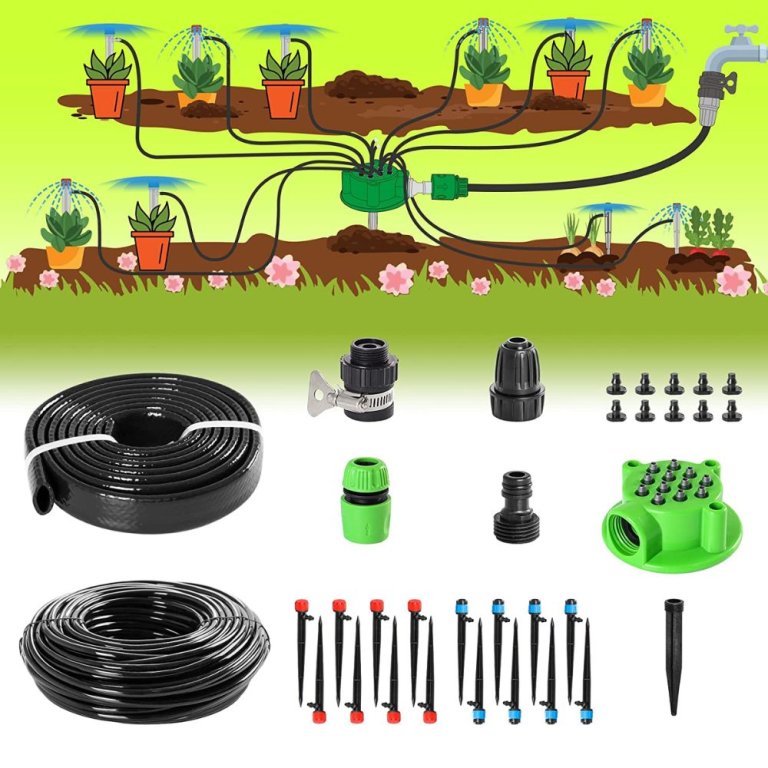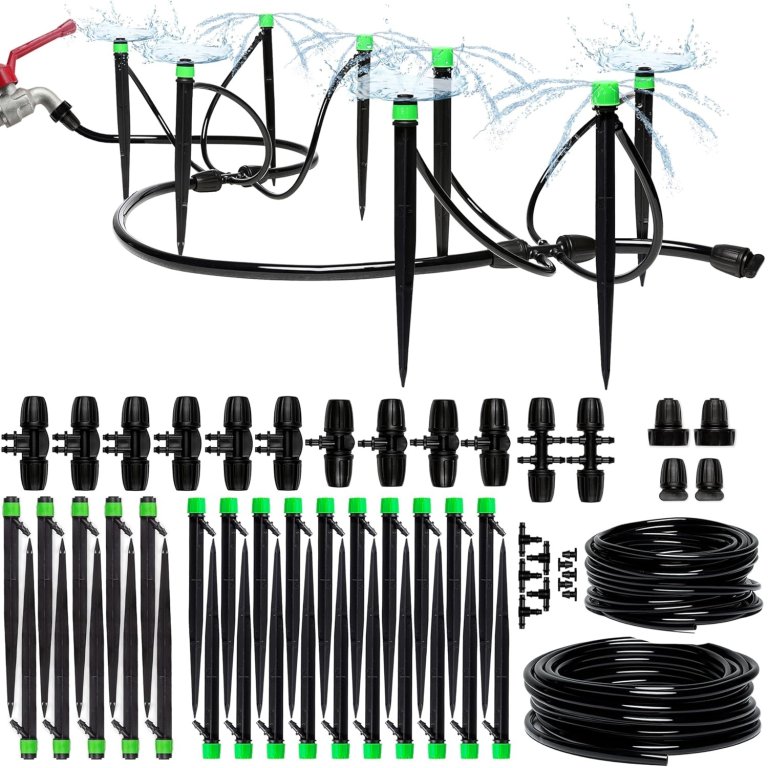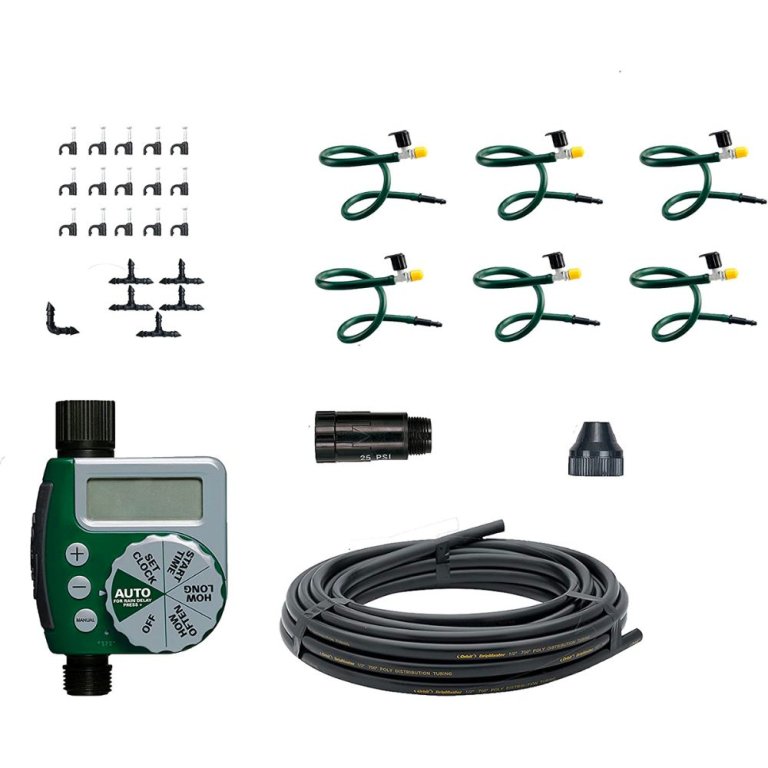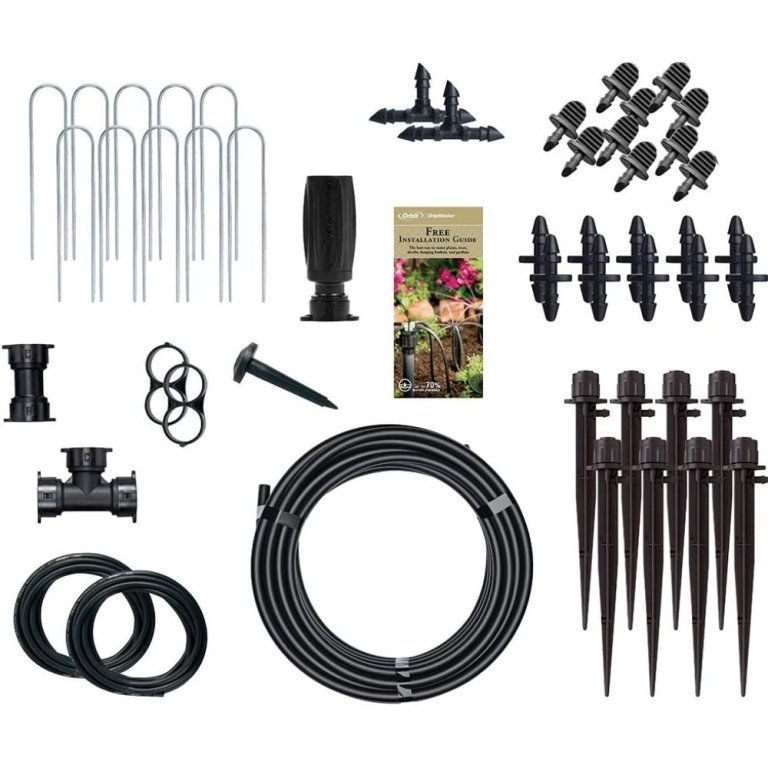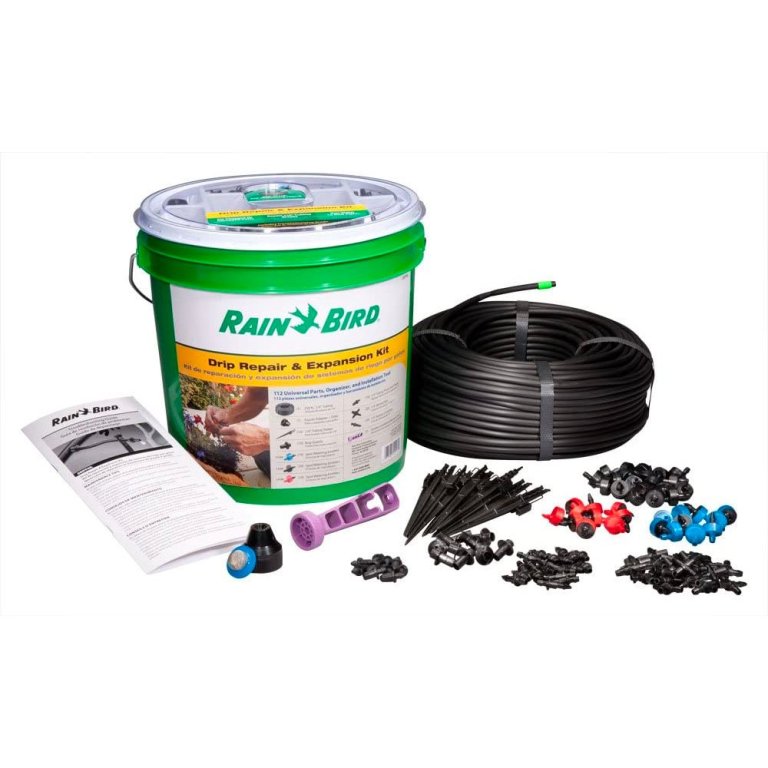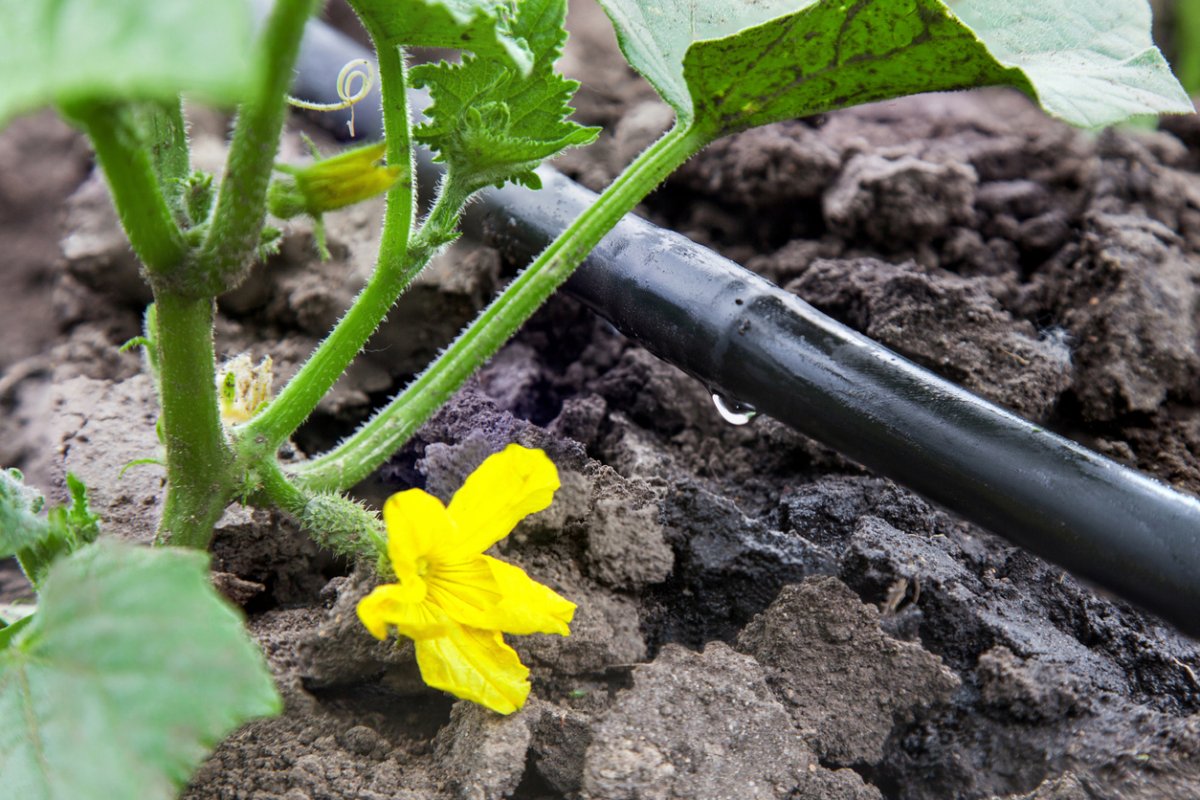
We may earn revenue from the products available on this page and participate in affiliate programs. Learn More ›
Keeping up with watering your garden can be challenging, but installing a drip irrigation system can ensure your plants never go thirsty. Drip irrigation is a system of hoses, nozzles, sprinklers, and tubes that deliver the proper amount of water to each plant, which helps you avoid both under- and overwatering. When set to a timer, these lawn care tools water automatically. They are also easy to install and maintain.
After researching dozens of highly-rated drip irrigation brands and models, our favorite is the Dig GE200 Drip & Micro Sprinkler Kit. It comes with 200 feet of irrigation tubes plus everything else you need to customize it to the shape and needs of your garden or landscaping beds.
To bolster our knowledge, we interviewed Todd Hendricks, founder of Louisville Landscape Pros in Louisville, Kentucky. “Drip irrigation systems are the most water-efficient irrigation system on the market and can reduce your water bills significantly, sometimes even up to 30 percent,” he says. Keep reading to learn how these worry-free plant watering systems work and review our lineup of some of the best drip irrigation systems on the market.
- BEST OVERALL: Dig GE200 Drip & Micro Sprinkler Kit
↓ Jump to Review - BEST BANG FOR THE BUCK: Bonviee Drip Irrigation Kit
↓ Jump to Review - BEST FOR RAISED BEDS: Carpathen Raised Bed Drip Watering Kit
↓ Jump to Review - BEST FOR HANGING POTS: Orbit Hose End Hanging Basket Watering Kit
↓ Jump to Review - BEST FOR CONTAINERS: Orbit Micro Watering Drip Kit
↓ Jump to Review - BEST FOR LARGE PLOTS: Rain Bird Drip Repair and Expansion Kit
↓ Jump to Review

Drip Irrigation Systems Comparison Chart
| Length | Filter | Additional Features | |
| Dig GE200 Drip & Micro Sprinkler Kit | 200 feet | None | Pressure reducer, mist sprayers |
| Bonviee Drip Irrigation Kit | 106.5 feet | None | 12-port manifold |
| Carpathen Raised Bed Drip Watering Kit | 50 feet of 5/16-inch tubing and 50 feet of ¼-inch tubing | None | Works on up to 3 raised garden beds |
| Orbit Hose End Hanging Basket Watering Kit | 50 feet | None | Pressure reducer, faucet timer, mist sprayers |
| Orbit Micro Watering Drip Kit | 50 feet of 0.5-inch tubing and 50 feet of 0.25-inch tubing | None | Hole-punch tool, micro bubblers, 3-in-1 faucet adapter |
| Rain Bird Drip Repair and Expansion Kit | 250 feet | Yes | Emitter installation and removal tool, faucet adapter |
Our Top Picks
Whether it’s raised beds or hanging baskets, there’s a watering system on this list for your needs.
Best Overall
Dig GE200 Drip & Micro Sprinkler Kit
See ItWhat We Like
- Adapters allow for shape and size customizations
- Covers up to 700 square feet
- Can be expanded to cover more area
- 2 guidebooks and online videos for setup guidance
What We Don’t Like
- Some complaints regarding the strength of the stakes
Specs
- Length 200 feet
- Filter None
- Additional features Pressure reducer, mist sprayers
This kit comes with everything you need to set up an extensive drip irrigation system. Its 124 pieces This kit comes with everything you need to set up an extensive drip irrigation system. Its 124 pieces include micro sprayers, drip emitters, 200 feet of irrigation hose, stakes to hold the irrigation tubing in place, and various adapters. There are also plenty of elbow and tee joints, making it easy to customize this garden watering system to suit the size and shape of the garden or landscaping bed.
In all, this kit can irrigate up to 700 square feet of gardens and landscaping and accommodate expansions of up to 1,000 square feet with the purchase of additional irrigation tubing. We like that setup requires no special tools, and Dig provides plenty of guidance for setting it up. Two guidebooks come with the sprinkler kit, and an instructional video is available online.
Get the Dig drip irrigation system at The Home Depot.
Best Bang for the Buck
Bonviee Drip Irrigation Kit
See ItWhat We Like
- Manifold design reduces parts needed for setup
- Works with garden beds, potted plants, and lawns
- Comes with easy-to-follow directions for setup and operation
What We Don’t Like
- Only has 12 emitters
Specs
- Length 106.5 feet
- Filter None
- Additional features 12-port manifold
This drip irrigation kit provides plenty of coverage for landscaping potted plants or a garden while still leaving enough money for plants and gardening supplies. It comes with 106.5 feet of drip irrigation tubing, 16 drip emitters, stakes, and a connector for the faucet.
This drip irrigation watering kit is also easy to set up thanks to its manifold design. The faucet connects to the manifold, then individual lines run from the manifold to each drip irrigation emitter and mini sprinkler head. There’s no need to connect multiple joints and adapters. The manifold is limited to just a dozen emitters and mini sprinklers, so it may not be suitable for larger gardens and beds.
Get the Bonviee drip irrigation system at Amazon.
Best For Raised Beds
Carpathen Raised Bed Drip Watering Kit
See ItWhat We Like
- Highly customizable with 4-way, 2-way, and 1-way couplers
- Constructed of UV-resistant and weatherproof material
- Provides drip irrigation for raised beds and gardens
What We Don’t Like
- Some user complaints regarding product durability
Specs
- Length 50 feet of 5/16-inch tubing and 50 feet of ¼-inch tubing
- Filter None
- Additional Features Works on up to 3 raised garden beds
This system from Carpathen makes it easy to keep plants in your raised beds adequately watered. It comes with 50 feet of 5/16-inch mainline irrigation tubing and 50 feet of ¼-inch irrigation tubing, plus 20 spray drip emitters and 10 vortex drip emitters. The emitters are adjustable, allowing you to choose the proper water flow for each plant.
We appreciate that this drip system for garden and raised bed use also contains 4-way, 2-way, and 1-way couplers, making customization easy. It works for up to three raised garden beds, as a grid system, or even as a water source for potted plants. It includes complete instructions to make set up a breeze.
Get the Carpathen drip irrigation system at Amazon.
Best For Hanging Planters
Orbit Hose End Hanging Basket Watering Kit
See ItWhat We Like
- Comes with a programmable faucet timer
- Accurate sprayer attachments are ideal for hanging planters
- Includes clips to secure the mini sprinklers
What We Don’t Like
- Not designed to work for gardens
Specs
- Length 50 feet
- Filter None
- Additional features Pressure reducer, faucet timer, mist sprayers
Hanging baskets add considerable beauty, but they can be a hassle to water using a watering can or wand. This drip irrigation kit from Orbit automatically waters your baskets, leaving you time to sit back and enjoy them. The system includes an automatic timer that will turn your system on and off according to your settings. It also features clips to pin the hoses in place so you can run them directly over your hanging baskets and tie in the nozzles.
Perhaps the best part of this dripping irrigation kit is its “Flex-Mist” flexible nozzle tubing that will hold its position, creating pinpoint accuracy and minimizing water waste. While this system works very well for hanging baskets, it would be difficult to retrofit it for other uses. The clips won’t keep hoses in place in a flower bed, likely leaving the nozzles in the dirt.
Get the Orbit hose-end drip irrigation system at Amazon, Lowe’s, or Walmart.
Best for Containers
Orbit Micro Watering Drip Kit
See ItWhat We Like
- Easily expandable to handle larger gardens
- Can cover up to 250 square feet
- Works for landscaping beds, gardens, and potted plants
What We Don’t Like
- Only comes with 8 bubblers, limiting its capacity
Specs
- Length 50 feet of 0.5-inch tubing and 50 feet of 0.25-inch tubing
- Filter None
- Additional features Hole-punch tool, micro bubblers, 3-in-1 faucet adapter
Watering containers can be tricky, but Orbit has figured out how to get the job done effectively with its Micro watering drip kit. It includes eight bubblers and all the necessary hoses and fittings to hook them up in pots and containers. The hose can hide behind a pot or run through it from the bottom. Either way will feed a bubbler to water an entire pot.
The kit will cover 250 square feet, but it only has eight bubblers. For this reason, large multiple-container gardens may require more kits. Perhaps the best way to use this Orbit system is as an expansion kit for an already-installed system.
Get the Orbit micro watering drip irrigation system at Amazon, Lowe’s, Ace Hardware, or Walmart.
Best for Large Plots
Rain Bird Drip Repair and Expansion Kit
See ItWhat We Like
- Multiple emitters are ideal for larger gardens
- Includes a filter and bug guards
- Comes with adapters and accessories
What We Don’t Like
- Expansion kit doesn’t include faucet connectors or valves
Specs
- Length 250 feet
- Filter Yes
- Additional features Emitter installation and removal tool, faucet adapter
While some folks run multiple drip systems, an easier approach for an extensive garden may be to expand the system you already have. This Rain Bird drip irrigation kit has all the fittings, nozzles, and drip-irrigation tubing you’ll need to run extra sections of drip irrigation across your property. It includes 40 pressure-compensating, self-piercing emitters and features a clever installation and removal tool that makes putting emitters and fittings into the lines much easier.
Just keep in mind that this is an expansion and repair kit; it doesn’t come with any faucet connectors or valves. It’s meant for making additions or fixes to your established system, not installing a brand-new one.
Get the Rain Bird drip irrigation system at Amazon, The Home Depot, or Shell Lumber.
Jump to Our Top Picks
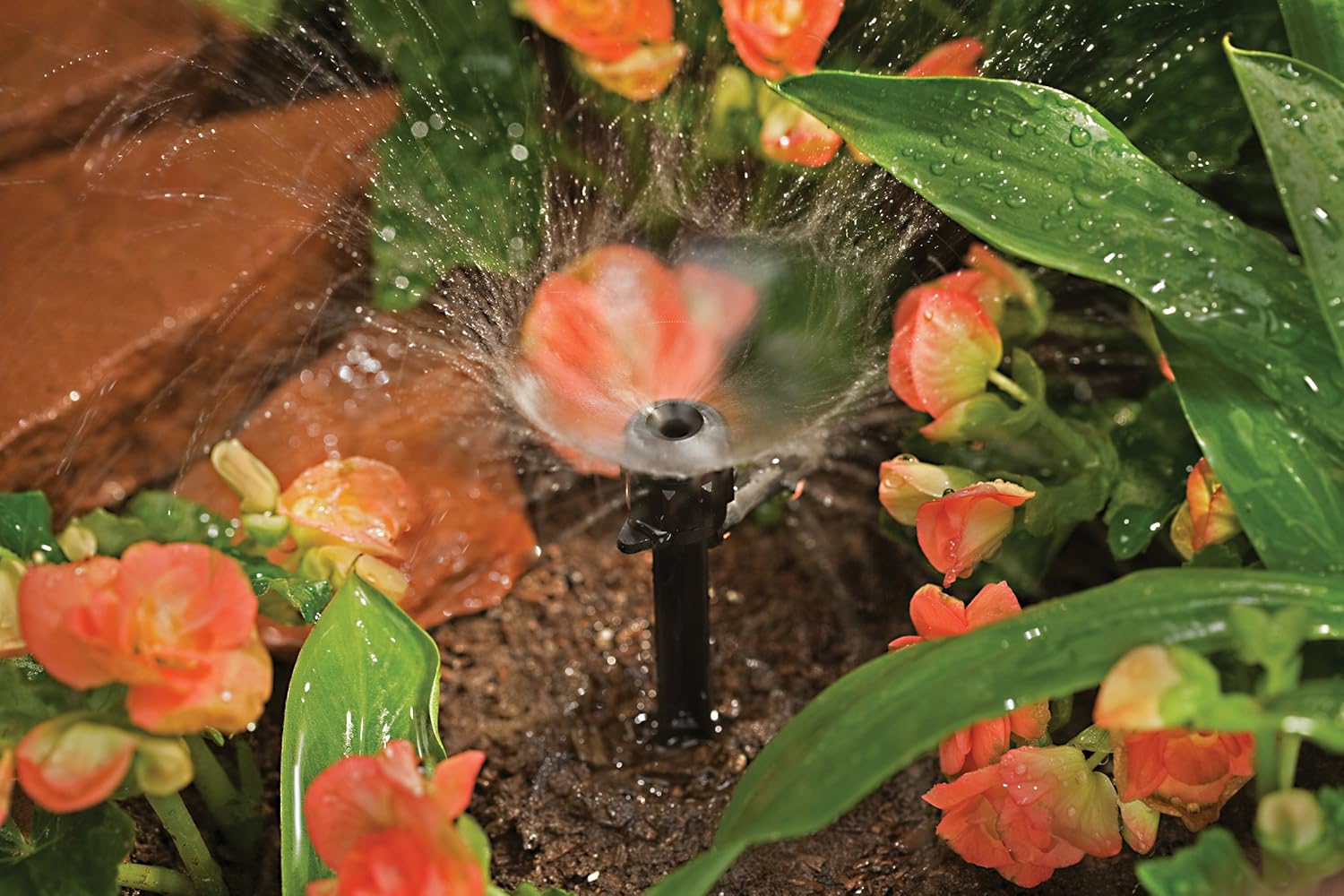
How We Chose the Best Drip Irrigation Systems
When curating our list of recommendations, we looked at the best brands on the market for drip irrigation systems, with tubing made from durable materials that are less likely to wear out in harsh outdoor weather. We made sure to include options for both small and large areas, with 50-foot-long tubing ideal for moderate-size gardens and up to as much as 250 feet long for larger tasks, such as watering the lawn. We included some options that are easily extendable when needed for budding green thumbs looking to install new planters.
Our research also took into consideration the various types of water systems for garden use. Our top picks include solutions for hanging planters, raised beds, containers, and large garden plots.
What to Consider When Choosing a Drip Irrigation System
Once you’re familiar with the different types of systems and emitters, you can focus on creating your garden’s ideal system. The size and type of garden, along with the type of soil and other factors, are worth noting and planning for. Here are some factors to keep in mind when buying a good drip irrigation system.
Types of Nozzles in Drip Irrigation Systems
Drip irrigation systems require several different emitter nozzles. Depending on your garden’s design and needs, some of these nozzles will be better suited than others. Before you attempt to plan out your irrigation system, familiarize yourself with the following types of emitter nozzles, each with strengths and weaknesses worth considering.
Micro-Spray Sprinklers
Micro-spray sprinklers, similar to lawn sprinklers, are helpful devices that can make the most of a low-pressure drip irrigation system. They install alongside taller plants or are used to hit a few plants with greater water needs while leaving less-needy plants alone. They’re designed with improved spray range over other emitter types with the same pressure. Construct micro-spray sprinklers from four pieces as follows:
- Run a length of 0.25-inch tubing to the sprinkler’s desired location.
- Attach tubing to a base with a stake driven into the ground.
- Use a piece of stiff tubing to create a riser and attach it to the base.
- Screw a micro-spray nozzle onto the end of the riser.
The riser allows the head to stand above taller plants and makes directing the spray easier. Micro-spray sprinkler heads often have built-in adjustable valves to control the spray.
Point-Source Emitters
Often favored by landscape gardeners and seen as great for plants that don’t do well with water on their leaves (like tomatoes and eggplants), point-source emitters are nonadjustable, preset nozzles that distribute a set amount of water to a plant per hour. They’re excellent for use with “satellite” plants in planters and hanging baskets as well as sensitive vegetables. Point-source emitters can be installed via a few different methods:
- Plugged directly into the main hose
- Installed under the plant with a length of tubing connecting to the main hose
- Plugged into the main hose with a length of tubing running to the plant.
Whichever way you install emitters, they’re usually preset at 0.5, 1, or 2 gallons per hour (GPH). You need to use a manufacturer’s chart to determine the correct nozzle for your particular plants. Too much water could drown plants that prefer to be a little dry, while too little water will stunt a plant’s potential.
In-Line Drip Emitters
For those with a more laid-back approach to garden irrigation, in-line drip emitters are a fast and easy way to distribute water. These hoses are smaller in diameter than the main hose but may come in various lengths. Emitters are built into tubing throughout its length, allowing gardeners to weave the hose in between plants and provide water without putting a bunch of emitters in the main hose. This is a low-maintenance and leak-reducing irrigation method.
In-line drip-emitter hose watering rates differ from point-source models, as they aren’t determined by GPH ratings. Generally speaking, in-line hoses come in 0.25-inch and 0.5-inch diameters, with spacing set between 6 and 12 inches. Check the manufacturer’s information to determine what you require for your particular garden systems watering needs.
Basin Bubblers
A potentially useful addition to your drip irrigation system, basin bubblers are small low-pressure sprinkler-style nozzles staked into the ground and connected to the drip system’s main hose. They spray water in a 360-degree pattern, hitting all the plants around them. They’re extremely helpful in a cluster of flowers and plants as they reduce the need for individual nozzles and are more convenient than manually watering with a watering wand.
These bubblers hook to the main hose with a small length of tubing. They’re simple to install and reposition, and pressure adjustments are easy to make at any time. The bubblers’ heads screw in or out to throttle the water flow.
Garden Size
The size of your garden will determine your system’s setup and the kit that you need. For smaller gardens, a single kit is often enough to install an effective drip irrigation system. Larger gardens may require additional lengths of tubing and emitters. You may even find that you’re better off with two separate systems that run at different times to different locations around your property.
Plant Types
Different plant species require different amounts of water. Depending on what you’re growing, you might have to get creative with a system of in-line and point-source emitters. One of the great values of a good drip irrigation system is how flexible it is. If designed correctly, a single system can water a wide variety of plants.
Soil Type
There are six types of soil—clay, sandy, silty, peaty, chalky, and loamy—all with varying nutrient contents and drainage characteristics. It’s important to understand the type of soil you have so you can choose the best drip irrigation system for your needs. Generally speaking, garden soil is a nice mixture of these soil types and tends to offer a good blend of nutrients and water-holding capabilities. If you’re watering raised or flower beds filled with garden soil, you shouldn’t have much issue making a drip irrigation system work for you.
Flow Rate
Once you’ve determined the plants and soil you have, you can figure out the plants’ water needs and choose the correct emitters to achieve the right flow rate.
Even plants with low water needs can suffer in fast-draining, fast-drying soils. In this case, you’ll need to increase the size of point-source emitters or use in-line tubing with closer emitter spacing. Consider a 1-GPH emitter or 9-inch spacing for these scenarios. You might even consider amending the soil with fertilizer or peat moss to increase nutrients and slow the drainage.
Plants with high water needs in poorly drained soils can also suffer if overwatered. If this is the situation in your garden, you may be better off purchasing half-gallon emitters or 12-inch-spaced in-line tubing to help keep your plants from drowning. You might want to work some sand into the soil as well to increase drainage.
Pressure Compensation
The amount of pressure that flows through a drip irrigation system can fluctuate depending on hose length and garden bed elevation, among other factors. This can cause emitters to flow differently than designed, with more or less water flow depending on pressure.
To combat this, the best drip irrigation system emitters are pressure compensating by design. They’ll emit the same amount of water regardless of the pressure at their inlet (where they attach to the main hose). They provide consistent watering conditions and ensure that all plants along the system stay watered.
Hendricks advises checking to see if your irrigation system has a pressure regulator. “If it doesn’t, check your irrigation kit to find out the recommended operating pressure. It should be labeled on the kit. Then, simply purchase a regulator for that pressure range,” he says.
Filters
You might not consider a filter important for your drip system—until you get a clog in your 0.25-inch tubing. Water systems often contain sediment, dirt, or even scaling from metal pipes, all of which can result in obstructions that limit water flow.
An in-line screen filter protects your system from these pressure-blocking particles. They install at the hose faucet and catch obstructions before they can make it into the system. If you notice water flow starting to reduce throughout your system, it’s a safe bet that you need to remove the screen and clean it out.
Self-Flushing Feature
Dirt, small insects, and other obstructions can make their way into a drip irrigation system through the emitters—and in-line screen filters can’t prevent these intruders. Some systems, however, come with automatic flush valves that help reduce the possibility of a clog. These valves install at the end of the system and will automatically open when the pressure in the system drops (like when the water shuts off). Residual water drains out of the system through these open valves, clearing some of the sediment that has collected.
Built-In Check Valves
The water to your home could be compromised if the water pressure suddenly drops when your drip system is running. In such a case, the hose faucet can back-feed water from the drip system into the house, resulting in a contaminated water system that isn’t safe to drink or use for bathing.
To reduce this risk, install a check valve in your system. These valves allow water to flow in one direction and shut off automatically when any back pressure occurs, or the pressure in the system behind it drops. If your drip irrigation system doesn’t come with a check valve, it’s important to purchase one and install it at the hose faucet.
Automatic Timers
Not all systems come with automatic timers, but most systems will benefit from one. “You can set [an automatic timer’s] watering schedule and adjust how long it turns on the water for and at what times of the day,” says Hendricks. “This way, you don’t have to manually turn on and off the water flow and you can ensure your plants have a regular, consistent watering schedule.”
You’ll have remarkably consistent results in your garden, and you’ll be able to regulate your water usage perfectly, ensuring you are watering plants at the best time possible. Plus, you needn’t remember to turn your system on or off. If your system doesn’t have an automatic timer, installing a faucet or hose timer may do the trick.
The Advantages of Owning a Drip Irrigation System
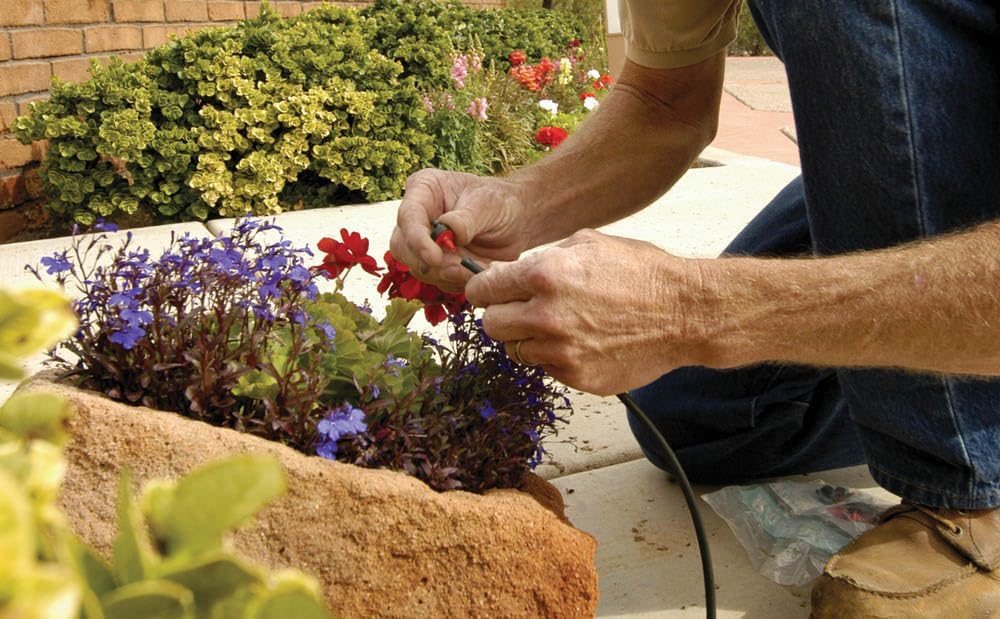
From easy installation to automatic watering to low maintenance, drip watering and irrigation systems will help create a better garden space for your home.
Drip line irrigation systems are easy to install because they require little to no digging. The main distribution hoses come in colors that match your mulch, and they tack into place with landscaping staples. The emitters install with barbed fittings that push into the distribution hose by hand. They can then be installed anywhere in the garden by inserting a stake into the ground.
Automatic watering is undoubtedly the biggest advantage of drip irrigation. When it’s tied into an automatic timer, you can rest assured that your garden is getting water every day, whether you’re home or not. This is a crucial benefit when gardening in extreme heat. Also, by pairing the right emitter to the plants, you’ll know exactly how much water each is getting per hour.
Drip irrigation systems are low maintenance; simply flush the system any time you notice reduced flow, and you’ll be back in business in no time. Repairs are simple, too. If a hose breaks, simply cut either side of it and install a hose connector. Even home dwellers with very little DIY experience can handle maintaining a drip irrigation system.
FAQs
Because drip irrigation systems and their various parts may be unfamiliar to many people, here are some answers to the most common questions folks often have about them.
Irrigation systems are typically sold in kits with all the fittings needed to tie into your home’s hose faucet. Then it’s merely a matter of choosing how to run the main hoses and where you’d like your emitters to be. The emitters install along the main hose by poking their plastic barbed fittings wherever you choose, ideally near the plants you’d like watered.
The simplest method for laying out a drip irrigation system is to use in-line emitter hoses. These hoses can snake around a garden bed between plants and flowers. Another approach, which is somewhat more complex, is to create zones (i.e., a stand of several plants in one area) and run branches of emitters to them, off the main distribution hose.
A drip irrigation system should last between 10 and 15 years. However, poly-drip irrigation lines are prone to damage from freezing temperatures and the sun’s ultraviolet rays, both of which can cause the lines to crack. As such, you should expect to replace some of the system’s components and tubing after 4 or 5 years.
Which type of drip irrigation is better depends on what you’re using it for. Drip tape is a long piece of tubing with a thin wall that lies flat until it’s filled with water, making it much easier to roll up than rigid tubing. Since it only lasts a few years and doesn’t bend well, it’s ideal for irrigating long rows of short-term crops. Drip line is thicker tubing and looks similar to a hose. It doesn’t roll up easily but lasts much longer than drip tape, making it a good choice for long-term use, such as in a garden or greenhouse.
While dripping hose irrigation systems are efficient and use less water than other systems, they require ongoing maintenance. The emitters are susceptible to clogging, especially if you have hard water, and leaks can be caused by rodents or other garden equipment. Professional drip irrigation installation may also be more expensive than traditional sprinkler system costs.
Flush your drip irrigation system every two to four weeks or whenever you notice signs of clogging, such as poor water flow. Some kits feature automatic flushing features that will flush themselves when they sense decreased water pressure.
Drip irrigation kits keep plants hydrated without wasting water. They’re also easy to set up and inexpensive, especially compared to underground sprinkler systems, making them worth it.
Morning is the best time of day for watering plants with drip irrigation, usually between 5 am and 7 am.
How deep you should bury your drip irrigation lines depends on the system and the plants you’re watering. Drip irrigation kits usually direct users to secure the irrigation lines to the ground with stakes, requiring no digging. Professionally installed drip irrigation lines, on the other hand, may be buried anywhere from a couple of inches to a foot deep. Refer to the manufacturer’s instructions for the proper setup of your drip irrigation kit.
Why Trust Bob Vila
Bob Vila has been America’s Handyman since 1979. As the host of beloved and groundbreaking TV series including “This Old House” and “Bob Vila’s Home Again,” he popularized and became synonymous with “do-it-yourself” home improvement.
Over the course of his decades-long career, Bob Vila has helped millions of people build, renovate, repair, and live better each day—a tradition that continues today with expert yet accessible home advice. The Bob Vila team distills need-to-know information into project tutorials, maintenance guides, tool 101s, and more. These home and garden experts then thoroughly research, vet, and recommend products that support homeowners, renters, DIYers, and professionals in their to-do lists.
